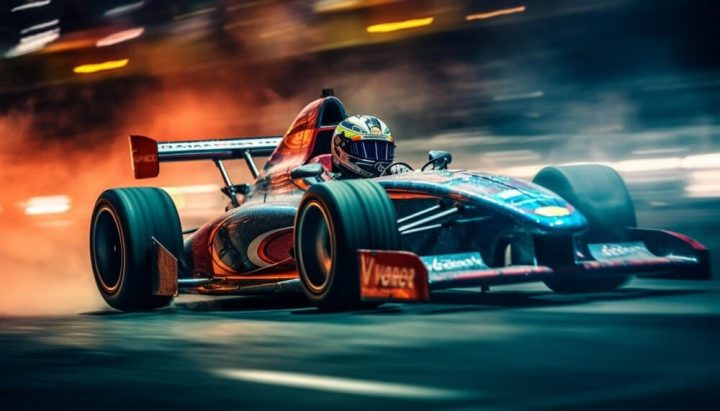What Makes Formula 1 Cars To Be So Fast?

There isn’t really any distinction between a Formula One car and the automobile you drive. They most likely have gearboxes, suspensions, wheels, brakes, tires, and internal combustion engines.
However, it is where the similarities end. F1 cars, in contrast to your car, aren’t made for cruising down the freeway. They are created for one purpose only: speed. This includes both the design and the exact materials utilized.
A current Formula One car can accelerate from 0 to 62 miles per hour in about 1.7 seconds, about a second faster than the fastest production car. Each can reach high speeds of almost 200 mph and produce more Gs in the turns than the Space Shuttle does during launch.
What, therefore, makes Formula One cars so incredibly fast? How is it possible for something that resembles a road automobile in general to reach such amazing speeds? Before delving deep, you can check if you are interested in the best Formula 1 sportsbook odds.
Engine Design
The 1.6-liter turbocharged V6 engines power Formula One cars with hybrid energy recovery technologies. Current Formula One vehicles can still produce 900bhp or more despite the engines’ drastic size reduction.
Short-stroke engines, similar to those used in motorcycles, are why F1 cars can produce so much power from a given engine capacity.
More in shape, like hockey pucks, are the cylinders found in Formula One cars. The engine’s narrow stroke means the pistons have a shorter distance to travel, increasing efficiency. Yet, the automobile can still take in the same quantity of gasoline and air because of its ample width and short length.
Therefore, a Formula One car can rev harder and higher thanks to the cylinder shape and sophisticated alloys that make the engines so durable.
Aerodynamics
The aerodynamic appearance of Formula One cars is almost as important as their engines. Racing cars are made to move quickly. To maintain stability on the road, a fast-moving vehicle needs to be able to produce downforce as well as reduce air resistance.
Since the drivetrain struggles to keep up with the pressure of the surrounding air, the low, wide, and flat design of F1 cars is intended to reduce air resistance, which could otherwise cause the car to slow down. Every car’s surface is designed to control airflow to maintain stability and speed.
All cars are equipped with splitters, wings, and diffusers to regulate the airflow around and over the vehicle. They function similarly to an airplane wing, but in reverse, pressing the car down to the road to maximize tire traction, especially while cornering.
Less aerodynamic drag enables the vehicles to reach such high speeds on straight roads, while more grip in the tires allows the enormous power the engine produces to hit the road beneath.
Gearboxes
Drivers of modern Formula One vehicles can swap gears with their fingertips thanks to sophisticated, highly computerized semi-automatic gearboxes connected to paddle shifters placed on the rear of the steering wheel.
Similar in design to dual-clutch automatic gearboxes found in everyday cars, a Formula One gearbox is computerized but not automatic, requiring the driver to enter each gear on their own and apply the clutch at the starting point, thereby stressing expertise.
The gearbox of an F1 car is substantially lighter than an ordinary car since it is made of unique low-weight elements like carbon alloys. This results in less resistance and quicker gear changes.
A standard Formula One car’s transmission can shift gears 50 times faster than a person can blink; in only 0.005 seconds, the car can engage a new gear, release the clutch, and dip the clutch.
Tires
The tires on a Formula One car are arguably the most crucial component of the whole thing. Since the tires are the only significant component of the car that contacts the ground, everything else, including the suspension and engine, depends on the tires to function.
Like every other component of an F1 car, the tires are subject to strict regulations. If they aren’t performing well, the car won’t perform well either. Teams used to run mostly on slick tires for years because they offered the greatest contact area between the road and rubber due to their lack of tread pattern. However, these days, the regulations are different.
Compared to road tires, even the toughest tires are incredibly soft rubber; the precise makeup is a closely kept trade secret among producers. Before the vehicles are entirely race-ready, drivers must complete a few laps to allow the tires to heat up and reach their maximum gripping power.
The amazing traction of the tires comes at the expense of reduced durability. Formula One tires are made to endure a maximum of approximately 125 miles, but a typical vehicle tire can last thousands of kilometers.
Brakes and KERS
The disc brakes on Formula One cars are essentially the same as those on conventional automobiles; the main distinction is that Formula One brakes must stop a car moving at 200 mph or faster.
Formula One cars’ carbon fiber pads and disks are designed to enhance performance and minimize wear and tear. This material can withstand heat that would melt most metals and force the brakes to fuse.
In addition to being substantially lighter than brakes used on regular cars, these effective brakes enable drivers to accelerate into turns for the fastest lap times.
The hybrid kinetic energy recovery system (KERS) in modern F1 cars collects kinetic energy that usually escapes as heat and returns it to the engine for an additional 80bhp of power boost that is accessible when needed.










